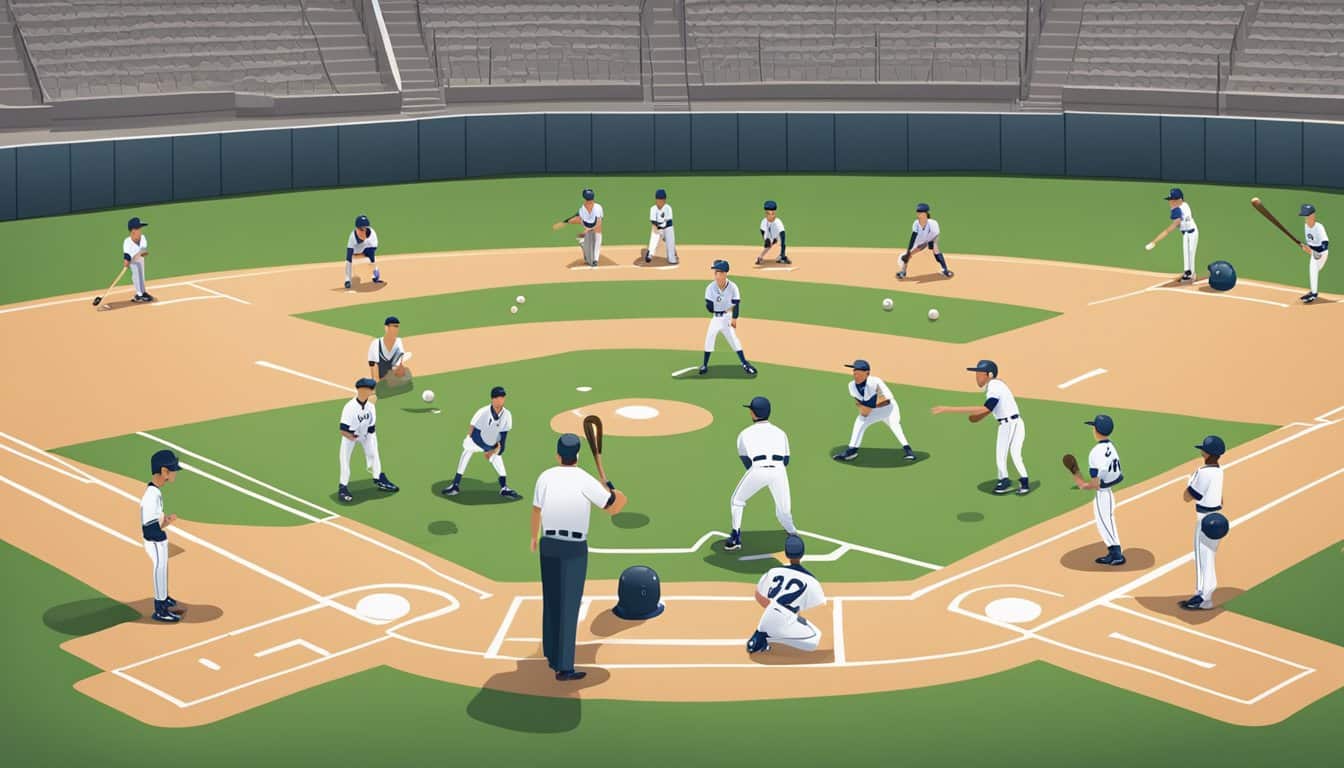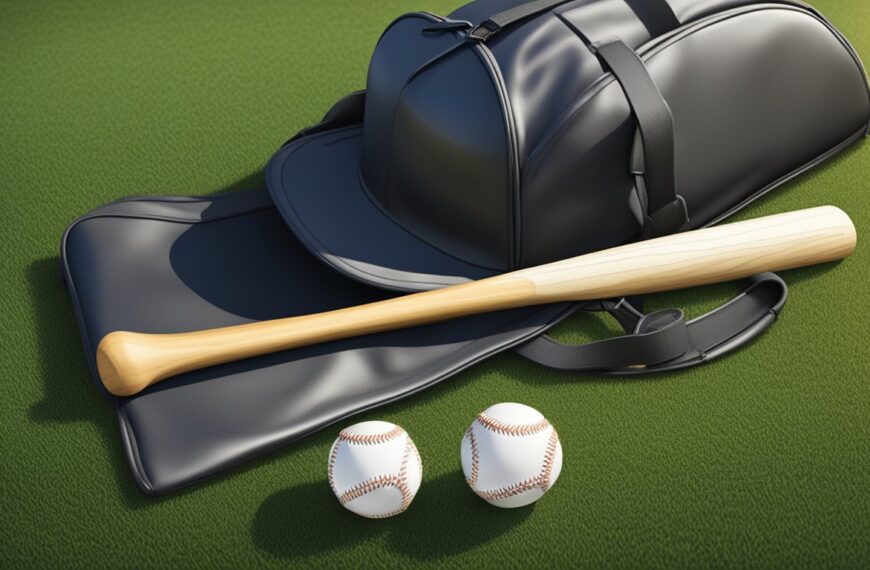Batting tee practice is a foundational exercise for baseball players aiming to improve their hitting skills. This form of practice allows players to focus on the mechanics of their swing without the variables introduced by a live pitcher. By breaking down the swing into manageable parts, players can repeat motions and build muscle memory more effectively. However, it is crucial to acknowledge that even in a controlled environment like tee practice, safety should never be an afterthought. Ensuring safe practices during these training sessions not only prevents injuries but also maximizes the effectiveness of the practice time.
To maintain a safe environment during batting tee practice, certain precautions must be adhered to, starting with the choice of equipment. Selecting the right batting tee that fits the individual player’s height and stance is the first step towards a safe practice routine. Proper setup of the batting tee is equally important to prevent it from tipping over during practice. Additionally, understanding and applying correct swing mechanics not only improve a player’s hitting but also reduce the risk of strain and overuse injuries. A focused practice routine that includes a variety of drills can aid in developing proficiency in hitting from different zones, ensuring a well-rounded skill set.
Key Takeaways
- Effective batting tee practice enhances swing mechanics and baseball hitting skills.
- Safety in tee practice is crucial to prevent injuries and ensure productive training.
- Proper equipment selection and focused drills are essential for a beneficial practice routine.
Choosing the Right Batting Tee
When selecting a batting tee, the player should consider various types of tees, key features for enhanced practice, and reputable brands. An appropriate choice can drastically improve batting skills.
Types of Batting Tees
Batting tees come in different designs, each tailored to specific training needs. Adjustable tees enable users to practice hitting at various pitch heights, crucial for developing a versatile swing. Weighted-base tees offer stability and reduce the likelihood of the tee tipping over during practice.
Features to Look For
A quality batting tee has certain features that enhance its longevity and effectiveness:
- Durability: Look for tees made with high-grade rubber or polyurethane that can withstand frequent use.
- Adjustability: A good range of height adjustments allows for a more comprehensive training experience.
- Portable design: Ease of assembly and disassembly contributes to convenient transport and storage.
Top Brands and Models
Several brands stand out for their high-quality batting tees:
- G Tee: Known for durability, with a stainless-steel and aluminum construction that offers smooth height adjustments.
- Tanner Tees: Features a hand-rolled rubber top and sturdy base, preferred by amateur and professional players alike.
| Brand | Model | Material | Feature |
|---|---|---|---|
| G Tee | Pro Low | Stainless steel, aluminum | Precision height adjustment |
| Tanner Tees | Original | Metal, hand-rolled rubber top | Lightweight, stable |
Setting Up Your Batting Tee
Proper setup of a batting tee is crucial for effective practice. It involves positioning the tee correctly, adjusting its height to suit the batter, and preparing the surrounding area to ensure safety and maximize training efficiency.
Ideal Placement
The tee should be positioned within a batting cage or a designated hitting area that provides sufficient space for swinging the bat. Placement is key; the tee should be situated in alignment with where the pitch would naturally crosshome plate. This placement mimics realistic pitch locations and encourages proper swing mechanics. For tee work to be effective, batters must position the tee in a manner that allows them to hit the ball toward all fields – pull side, up the middle, and opposite field.
Adjusting Tee Height
To accommodate the batter’s strike zone, adjust the tee height so that the ball sits level with the midpoint of the batter’s torso when they are in their batting stance. Use the following guide:
- For lower-pitched balls: adjust the tee closer to the height of the batter’s waist.
- For higher-pitched balls: raise the tee to chest level.
The goal is for the batter to practice making contact at various strike zones, enhancing their ability to hit pitches all over the strike zone.
Preparing Your Practice Area
Before starting tee work, inspect the area around the batting tee. Clear the space of any obstacles that might interfere with batting or pose a safety risk. Ensure the ground is level to prevent the tee from tipping over. It also helps if the batter is on a surface that simulates the feel of a batter’s box.
When using a batting cage, there should be adequate netting to contain balls hit off the tee. Position the batting tee far enough from the net to avoid ricochet and to give a clear indication of the ball’s trajectory after it’s hit.
Mastering the Swing Mechanics
https://www.youtube.com/watch?v=fG7020cZM1Q&embed=true
Developing a consistent and powerful swing is essential for any batter. Mastering swing mechanics involves a focus on stance, grip, and the processes that lead to the perfect swing. Attention to detail in these areas can significantly enhance a player’s batting performance.
Stance and Grip
A batter’s stance should be stable and comfortable, with feet shoulder-width apart and knees slightly bent. The weight should be distributed evenly, allowing for quick movements in any direction. Proper grip is also crucial; one should hold the bat with both hands close together, knuckles aligned, ensuring the bat is gripped firmly but not too tightly. The grip is the foundation for control and power in the swing.
-
Proper Stance:
- Feet shoulder-width apart
- Knees slightly bent
- Even weight distribution
-
Proper Grip:
- Hands close together
- Knuckles aligned
- Firm yet flexible grip
Hand-Eye Coordination
Efficient hand-eye coordination is pivotal for timing the swing to connect with the ball. Drill exercises that focus on watching the ball from the pitcher’s release point to the point of contact can greatly improve a batter’s ability to track the ball effectively.
- Drill Exercises:
- Tracking the ball from release to contact
- Repeated swings to build muscle memory
Generating the Perfect Swing
The perfect swing is a combination of mechanics and timing. It starts with a rotational movement of the hips, initiating the swing, while the hands drive the bat through the strike zone. A strong follow-through ensures maximum power and better control over the ball’s direction. Continuous practice is key to developing a swing that is both forceful and precise.
- Swing Mechanics:
- Hip rotation to initiate the swing
- Driving hands through the strike zone
- Strong follow-through for power
Developing a Focused Practice Routine
To increase batting efficiency, one needs to establish a disciplined practice routine focusing on consistent swings and incorporating visualization techniques. This focused approach elevates a batter’s skill through repetition and mental preparation.
Creating a Hitting Routine
A structured hitting routine is integral to a batter’s progression. The routine should include a set of drills tailored to the individual’s current level and targeted areas for improvement. For instance:
-
Warm-up exercises: These might consist of dynamic stretches and light cardio to prepare the muscles for batting practice.
-
Tee drills: The batter should perform a series of off-tee exercises to practice hitting balls at different heights and angles, which could look like the following:
- High Tee: 10 swings
- Middle Tee: 15 swings
- Low Tee: 10 swings
-
Skill-specific drills: Focused activities should isolate and develop particular batting skills such as power hitting or opposite-field shots.
Increasing Swing Consistency
Swing consistency is achieved through deliberate and continuous practice. A batter should:
- Analyze swing mechanics: Assess the stance, grip, and follow-through for each swing to identify and correct inconsistencies.
- Repetition: Execute multiple sets of swings, ensuring each swing is as similar to the last as possible, thus reinforcing muscle memory.
Creating a checklist for each session can also be beneficial, for example:
- Stance
- Eye on the ball
- Level swing
- Full follow-through
Using Visualization
Mental rehearsal, or visualization, is a powerful tool to improve batting performance. A batter should spend time visualizing the perfect swing and imagining various pitch scenarios. Here are key visualization techniques:
- Mental run-through: Before swinging, the batter should close their eyes and mentally picture a successful hit.
- Detailed imagery: They should imagine the feel of the bat, the sound of contact, and the trajectory of the ball.
- Situational practice: Visualizing different game situations can prepare the batter to adjust their swing accordingly.
Drills and Techniques for Improvement
https://www.youtube.com/watch?v=pzvT71bYw8A&embed=true
Effective batting tee practice is built upon structured drills that aim to enhance a hitter’s mechanics, timing, and spatial awareness. A diverse array of drills and consistent repetition form the cornerstone of development for hitters at any level.
Tee Drills for Different Pitches
High Tee Drill: It targets the player’s ability to handle pitches in the upper strike zone. The tee should be set at chest level, and the hitter focuses on driving these high pitches with a slight uppercut swing, aiming to hit line drives into the outfield.
Low Tee Drill: Set the tee at knee height to practice hitting lower pitches. The batter should work on maintaining a level swing and hitting the bottom half of the ball to avoid grounding out.
Situational Hitting
Opposite Field Hitting Drill: Batters should place the tee on the outer third of the plate and practice driving the ball to the opposite field. This drill improves their ability to adjust to outside pitches and enhances their plate coverage.
Runners on Base Drill: Simulate game situations with runners on base. Hitters should focus on hitting ground balls and line drives to the right side of the field to advance base runners from second to third.
Variety and Repetition
Random Pitch Drill: To mimic the unpredictability of live pitching, set up tees at various heights and locations around the strike zone. The hitter rotates through each tee, practicing hitting different pitch locations with each swing.
Consistent Repetition: Emphasize the repetition of proper mechanics with each swing. Set a goal for a certain number of swings per practice session, and ensure that each swing is executed with a focus on form and technique.
Hitting from Different Zones
https://www.youtube.com/watch?v=PIuzV5FtzS4&embed=true
To become a proficient hitter, one must practice hitting balls pitched in different areas of the strike zone. This not only enhances their batting technique but also prepares them for a variety of pitch locations during games.
Practicing the Low Ball
When practicing the low ball, hitters should focus on keeping their body balanced and eyes level. Adjusting the tee: Position the tee at the lower boundary of the strike zone—just above the knee height—to simulate low pitches. Stance: A slightly wider stance can provide added stability. Hitters should drive through the ball with their legs, ensuring the bat’s angle stays high enough to avoid hitting the ground.
Hitting to the Opposite Field
Hitters must develop the skill to hit to the opposite field, which involves timing and bat path. Bat path: The bat should make contact with the ball when it is deep in the zone, allowing the ball to travel to the opposite field. Timing: Waiting on the pitch and not rushing the swing is crucial; they should let the ball come to them.
Pulling the Ball Effectively
Pulling the ball with power and accuracy requires proper hip rotation and hand placement. Hip rotation: The hitter should initiate the swing with a quick and controlled turn of the hips. Hand placement: Hands should stay inside the ball, and the bat should follow a path that allows for contact out in front of the plate to pull the ball effectively.
Safety and Maintenance
Ensuring the safety of players during batting tee practice is paramount, as is the proper maintenance of the equipment. Regular equipment checks reduce the risk of accidents and extend the lifespan of the batting tee.
Ensuring Safe Practice
- Correct Setup: Ensure the batting tee is positioned on a stable, flat surface to prevent it from tipping over.
- Proper Distance: Batters should stand at a safe distance to avoid being hit by the bat during a swing.
Caring for Your Batting Tee
- Clean Regularly: Wipe down the tee with a damp cloth after use to prevent buildup of dirt and grime.
- Storage Protocol: Store the batting tee in a cool, dry place to prevent warping and deterioration.
Regular Equipment Checks
- Inspection Schedule: Conduct a thorough inspection of the batting tee at least once a month.
- Checklist:
- Examine the rubber tee top for cracks or tears.
- Assess the stability and structural integrity of the base.
- Tighten any loose connections.
Periodic assessments and proper care ensure the longevity and safety of the batting tee.
Leveraging Training Aids
https://www.youtube.com/watch?v=oUuR-w8yrwQ&embed=true
Training aids significantly enhance skill development during batting tee practice. They can create realistic pitch scenarios, provide consistent repetition, and help build muscle memory more effectively.
Incorporating Soft Toss
Soft toss is a drill that enhances a batter’s timing and hand-eye coordination. Using soft toss machines allows for consistent ball placement, which helps the batter to focus on their swing mechanics without the unpredictability of a human tosser. The batter stands next to the machine and swings as the ball is gently tossed into their hitting zone, allowing for a more efficient practice.
Using a Pitching Machine
A pitching machine enables batters to simulate various pitch types at different speeds. This tool is essential for improving reaction times and offers a more challenging and diverse practice environment. It’s important that batters adjust the machine properly to align with their strike zone, ensuring that they can practice hitting pitches as they would in a game setting.
Other Helpful Training Tools
An array of other training tools can be used to supplement batting tee practice:
- Weighted bats: To enhance strength and swing speed.
- Swing analyzers: Provide data on swing mechanics.
- Practice balls: Varied in hardness and weight for different drill types.
- Netting: To safely contain batted balls and allow for practice in confined spaces.
By integrating these training aids, batters can experience comprehensive improvement in their batting technique and performance.
Advancing from Tee Work to Live Pitching
https://www.youtube.com/watch?v=ELo4zAOKTkg&embed=true
The progression from hitting off a tee to facing live pitching is a critical phase in a player’s development. This transition requires a strategic approach to mastering timing, improving pitch recognition, and building the necessary confidence to face live pitchers effectively.
Transition Techniques
Players should gradually increase the difficulty of their batting practice. Starting with soft toss and moving onto short toss, they can simulate the speed and trajectory of live pitching. It’s important for hitters to maintain the mechanics they perfected during tee work while adjusting to the movement and pace of the ball.
- Soft Toss: Begin with an underhand soft toss to get accustomed to a moving ball.
- Short Toss: Progress to overhand tosses from a short distance, focusing on quick reaction times.
Timing and Pitch Recognition
Timing is crucial when facing live pitching. Players must learn to read the pitcher’s release point and the ball’s trajectory quickly. Utilizing drills that incorporate various pitch speeds and locations can enhance a batter’s ability to adjust their swing timing accordingly.
- Recognize the Release Point: Identify and react to different release points.
- Adjust to Pitch Speeds: Use a pitching machine or live arm to vary pitch speeds and develop timing.
Building Confidence Against Pitchers
Confidence at the plate is often the product of repeated successful encounters with live pitching. Hitters should practice against different types of pitchers, from those who rely on speed to those with a knack for off-speed pitches. It’s essential to simulate game conditions as much as possible to build the batter’s confidence.
- Face Different Pitchers: Challenge yourself by hitting against a variety of pitchers.
- Simulate Game Conditions: Incorporate practice that mimics real game scenarios to enhance confidence.
Engaging Youth and Beginner Players
https://www.youtube.com/watch?v=XwHLwDVRjjU&embed=true
When introducing young and beginner players to batting practice, it’s vital that they learn correct form and develop a healthy mindset towards the sport. These foundational aspects shape their future in baseball.
T-Ball Fundamentals
T-Ball serves as an introductory level of baseball for young children, focusing on basic skills and safety. Coaches should emphasize proper stance, grip, and eye coordination. Here’s a quick breakdown:
- Stance: Feet should be shoulder-width apart.
- Grip: Hands together on the bat, dominant hand above the other.
- Eye Coordination: Eye on the ball throughout the swing.
It’s important for them to practice these steps repetitively, as muscle memory plays a significant role in their development.
Building Basic Hitting Skills
Developing core batting skills involves a structured approach to practice. Coaches should:
-
Start with dry swings (no ball): It helps to build the motion without the pressure of hitting a ball.
-
Progress to hitting a stationary ball on a tee: Gradual increase in difficulty helps maintain confidence.
-
Practice different hitting zones: Move the tee to practice hitting balls in different areas of their strike zone.
-
Use soft compression balls for safety and to reduce fear of impact.
Consistency in practice is key, as repetition enhances skill retention and muscle development.
Encouraging a Positive Attitude
For youth and beginners, maintaining a positive experience is critical to their continued interest and improvement in baseball. Coaches and parents should:
- Provide constructive feedback, focusing on what the player is doing right and how they can improve.
- Celebrate small successes to build confidence.
- Maintain a patient and supportive environment where mistakes are part of learning.
By nurturing a positive attitude, young players are more likely to embrace practice and persevere through the challenges of learning.
Role of Coaches and Instructors
https://www.youtube.com/watch?v=G_n_tlesB-I&embed=true
Coaches and instructors play a crucial part in developing players’ skills and ensuring safety during batting tee practice. They guide the structure, focus on mechanics, and aim to improve the overall batting capabilities of their teams.
Structuring Effective Practice Sessions
Objective: To create a practice environment that maximizes learning and skill development.
-
Preparation: Coaches should prepare sessions based on players’ skill levels and goals.
- Assess individual and team needs
- Allocate time for warm-up, main activity, and cool-down
-
Execution:
- Use drill variations to prevent monotony and engage players
- Enforce safety measures such as proper spacing and net use to prevent accidents
Improving Player’s Hitting Mechanics
Focus: To enhance the technical aspects of a player’s swing using the batting tee.
-
Observation: Instructors should watch for and correct:
- Stance and grip
- Swing plane and point of contact
- Follow-through and balance
-
Feedback:
- Provide immediate, clear, and constructive criticism to reinforce proper techniques
- Use video analysis to demonstrate improvements and areas that need attention
Enhancing Team’s Overall Batting
Goal: To increase the batting proficiency of the team collectively through focused tee practice.
-
Individual Attention:
- While working with the team, coaches must address individual progress.
- Tailor drills to challenge and advance each player’s skill level.
-
Team Drills:
- Implement group activities that encourage healthy competition and teamwork.
- Regular progress assessments to track improvement and motivate players.
Frequently Asked Questions
Ensuring safety during batting tee practice is crucial. Each question addresses a specific aspect of safety to help avoid any accidents or injuries during practice.
What are the best practices for setting up a batting tee to ensure safety?
One should ensure the tee is positioned on a stable, flat surface and adjusted to the correct height relative to the batter’s swing zone. It’s important to verify that all components of the tee are tightly secured before use.
Can you describe the proper stance and positioning for hitting off a tee?
Batters should maintain a balanced stance with feet shoulder-width apart. They need to align themselves so the ball is central to the stance, allowing for a level swing path and minimizing the risk of losing balance or mis-hitting.
How can players effectively incorporate safety gear during tee practice sessions?
Players should wear helmets with face guards, batting gloves, and proper shoes to protect against potential impacts from the ball. Using safety gear can prevent injuries and instill confidence while hitting.
What precautions should be taken to maintain a safe distance from the tee and ball during practice?
Batters should ensure there’s ample space around the tee to swing freely without obstruction. Observers or other players should stand behind protective netting or at a safe distance to avoid being struck by batted balls.
What types of balls are safest to use for batting tee drills?
Soft practice balls or safety balls are recommended, especially for younger players, as they mitigate the risk of injury from a batted ball. Regular baseballs and softballs can be used by more experienced players with added caution.
How often should equipment be checked for wear and tear to prevent accidents during batting practice?
Regular inspections before and after practice are essential. Look for cracks, loose parts, or any signs of damage on the tee, balls, and safety gear to ensure they are in good condition and safe for use.













